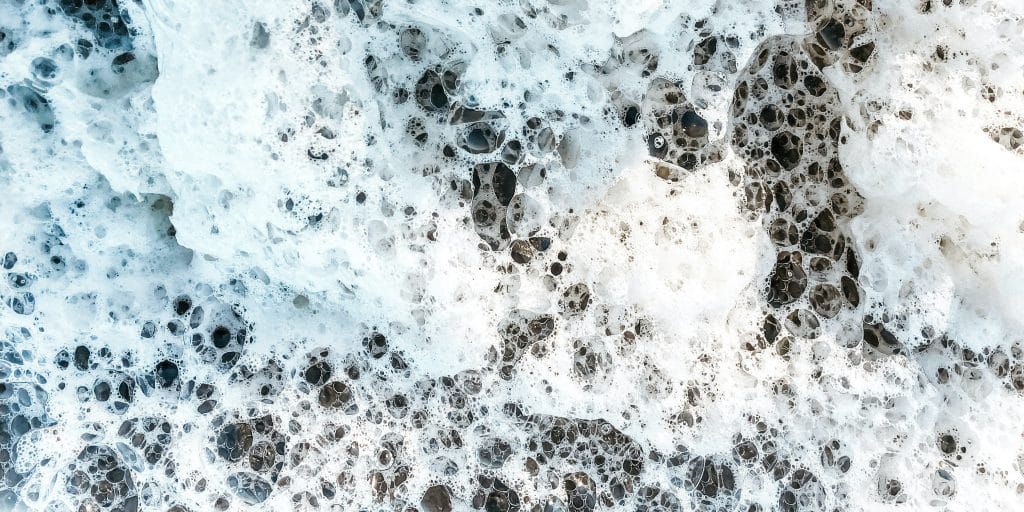Foaming is the formation of bubbles or foam on the surface of the liquid or throughout the solution. In cleaning applications, the formation of foam can offer several benefits, such as increased contact time, enhanced visibility and lubrication with the surface intended to be cleaned. However, in spray tank mixtures these features are not necessary for the application of herbicides. It is therefore important to understand why foaming might occur.
- Agitation: Air tends to get trapped in spray tank solution due to mixing and can result in the formation of foams results. This is likely during excessive or vigorous solution mixing.
- Surfactants: Most adjuvants used in spray tank mixtures contain at least one type of Nonionic surfactant. One of the primary roles of these surfactants is to reduce the surface tension of water. As a result, this makes air easier to enter the solution and form bubbles or foam. Lower surface tension means that less energy is required to form bubbles. Some surfactants facilitate the stabilization of foam. Nonionic surfactants can play a significant role in stabilizing foams, particularly when used in combination with other types of surfactants. The stabilization comes from the surfactant’s ability to reduce the surface tension of the liquid and prevent the coalescence of the foam bubbles. The amount of surfactant present can affect the degree of foaming. Below a certain concentration known as the critical micelle concentration (CMC), surfactants primarily exist as individual molecules. Above the CMC, surfactants form structures called micelles in the solution, leading to increased foam formation and stabilization. The foaming properties of surfactants can also be influenced by external factors like temperature, pH, and the presence of salts or other solutes. These features of surfactants are difficult to predict for a pesticide applicator because they are determined by the adjuvant and pesticide formulators.
- Tank mixing order: The order in which products are mixed in the tank can influence foaming. Some products might need to be added before others to prevent excessive foam. Therefore, always follow the label recommendation.
- Type of Water: The quality and type of water used can affect foaming. Hard water or water with various dissolved salts and minerals can sometimes increase foam formation.
- Pouring Technique: Pouring products rapidly or from a great height can introduce more air and lead to foaming. The formation of foam of leaf surface can increase the rate of evaporation of herbicide solution and decrease efficacy.
Foaming can be problematic for spray tank mixtures because it can reduce the effectiveness of the spray application and increase the risk of off-target movement of herbicides. They are specific ways in which foaming can be problematic.
- Spray rate: The presence of foam reduces the effective volume of the spray solution and can lead to inaccurate spray application rates.
- Inconsistent Application: Foamy solution may not be applied evenly on the intended surface, leading to inconsistent treatment.
- Equipment Wear: Foam can lead to increased wear on equipment parts due to inconsistent fluid flow and potential air pockets.
- Off-target movement: Foam can also increase the risk of off-target movement of herbicides, as it can be carried by wind or drift to nearby crops, vegetation, or water sources. This can cause damage to non-target plants and contribute to environmental pollution.
- Waste of Product: As foam can reduce the effective volume of the spray solution, there might be waste because of incomplete application.
It is basically impossible to eliminate foaming completely. Therefore, it must be managed in cases where it has a significant potential to become problematic. To reduce the impact of foam on spray tank mixtures, pesticide applicators may use anti-foaming agents or low-foam surfactants. These products can reduce the formation of foam and improve the performance of the herbicide application.
Defoamers or Antifoaming agents can be formulated within the adjuvant formulation or can be added directly to a tank mix to manage foaming. It’s worth noting that the selection of an appropriate defoamer must consider the specific process, as effectiveness can vary based on the liquid’s pH, temperature, and the presence of other ingredients or chemicals. Additionally, defoamers should be used at the right concentration; too much can cause the product to destabilize or even induce foaming, while too little might not suppress foam effectively. Therefore, it is important to use the correct amount of anti-foaming agent. Brewer International produces products with antifoaming ingredients that reduce the formation of foaming, such as Brewer 80-20, Brewer 90-10, Big Sur 90, Big Wet, Silnet 200, Silenergy, Sun control and Sun Energy. In addition, we provide our Brewer Defoamer that can be added directly to a tank mixture.
Ready to start something great?
Let us help you decide if our products are the right fit for you by answering any questions you may have.



